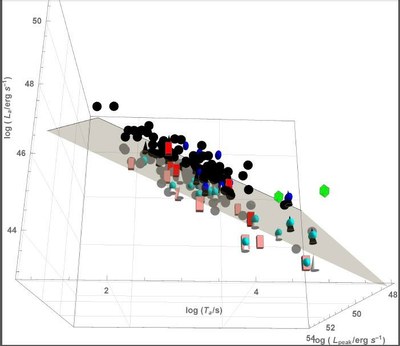A 3D step towards sorting out the Gamma-Ray Bursts zoo
A powerful tool for characterizing and classifying gamma-ray bursts (GRBs) to allow their use as tracers of the expansion history of the universe has recently been
presented by an international team of researchers led by Dr. Maria Dainotti, Marie Curie' outgoing Fellow at INAF, Italy and Stanford University, USA and assistant Professor at Jagiellonian University, Poland. The work, which has been published in the Astrophysical Journal, is a statistical analysis of the properties of the yet mysterious GRBs, aimed at determining a sub-group of GRBs and investigating the physical origin of these systems.
GRBs are the most powerful high energy events known, lasting anything between a few second to a few hours: during their short lived phase of very high-energy gamma-ray emission (called the prompt), they emit the same amount of energy the Sun releases over its entire lifetime. Thus, they are detected out to distances such that their light has been travelling towards us since the universe was only a thousandth of its current size. Despite having been observed for decades, there is still precious little definitively known regarding the physical mechanisms which produce them. There is in fact no shortage of proposed origins, including the explosions of extremely massive stars, the merger of two neutron stars or the spin down of magnetized massive
stars.
Not only is the interest in GRB studies geared towards coaxing out their origins, but, as they can be detected out to much earlier epochs than supernovae, if astronomers could ascertain their detailed physical characteristics, in particular the intrinsic luminosity of each distinct observed GRB, they could be used to trace the expansion history of the universe out to significantly more remote cosmological times than currently possible.
Lead author, Dr. Maria Dainotti, has shown that by considering the details of the less energetic but much longer lasting X-ray
'afterglow' plateau phase a sub-class of long GRBs can be defined such that a very tight correlation appears between the duration of the X-ray plateau phase, its luminosity, and the luminosity of the prompt gamma ray feature, see Fig 1. This 3-parameter correlation pinpoints a plane in which the axes, length, width and height represent these quantities.

The picture shows the La (luminosity at the end of the X-ray plateau), Ta (the rest frame duration of the plateau) and Lpeak, (the peak luminosity in the prompt emission) space, with a plane fitted using 183 GRBs observed by Swift, including GRBs with a SNe associated (cones), X-ray flashes (spheres), Short with Extended Emission (cuboids), long GRBs (circles), and ultra-long GRBs (polyhedrons). Darker colors indicate data above the plane, while lighter colors data below the plane.
In this present paper, the researchers have shown that by sub-dividing the sample into categories, the plane identified by gold GRBs, the ones with very well-defined and not so steep X-ray plateaus, shows an even smaller scatter compared to the planes derived from the other classes. This suggests its use for cosmological studies where it is essential to know the precise brightness of the cosmological tracers used, as well as identifying the average distance to this plane as a crucial parameter leading to the identification of distinct underlying physical processes behind the various classes.
There is evidence for a different physical origin for short GRBs presenting extended emission from the other various classes. This last is of relevance to the nascent field of Gravitational Wave astronomy, where a distinct signal might hence be expected in connection to events having a short or long GRB association. Thus, the distance from fundamental planes featured by GRBs with certain characteristics, for example, gold GRBs, becomes a crucial tool to discern among GRB categories and thus lead to a more profound understanding of their nature. There is a statistical difference between the gold sample plane and the plane identified by short with extended emission.
Looking for these subsamples and categories resembles walking through an impenetrable jungle whilst listening to the calls of unknown animals in the distance; a certain
distinction between long and short calls will appear, but
a wild assortment of sounds will remain. If however, one begins a more subtle classification
based on other finer features, class-specific groupings with
much tighter and meaningful trends will become evident.
Dr. Dainotti, together with the team of scientists in the current publication (Dr. Xavier Hernandez from UNAM, Mexico, Dr. Sergey Postnikov from Indiana University, Bloomington, Dr. Shigehiro Nagataki from RIKEN, Japan, Prof. Paul Obrien and Prof. Richard Willingale from Leicester University, UK, and Ms Striegel from San Jose State University, USA) and others are taking steps towards the identification of the diverse mixture of species which comprise the Gamma Ray zoo, a very challenging program which will ultimately allow to determine the physical mechanisms responsible for the many Gamma Ray varieties, and finally fulfill the promise of their use as cosmological probes.
Video Interview to M.G. Dainotti (in Italian language; here a version with subtitles in English)
Notes:
- The paper ‘A Study of the Gamma-Ray Burst Fundamental Plane’ by Dainotti, M. G., Hernandez, X., Postnikov S., Nagataki S., Obrien, P., Willingale, R. Striegel, S. has been accepted for publication in the Astrophysical Journal and it will be published the 17th of October. The preprint can be downloaded from: http://adsabs.harvard.edu/abs/2017arXiv170404908D
- M.G. D. acknowledges the Marie Curie’ Program, because the research leading to these results has received funding from the European Union Seventh Framework Program (FP7-2007/2013) under grant agreement no. 626267.




